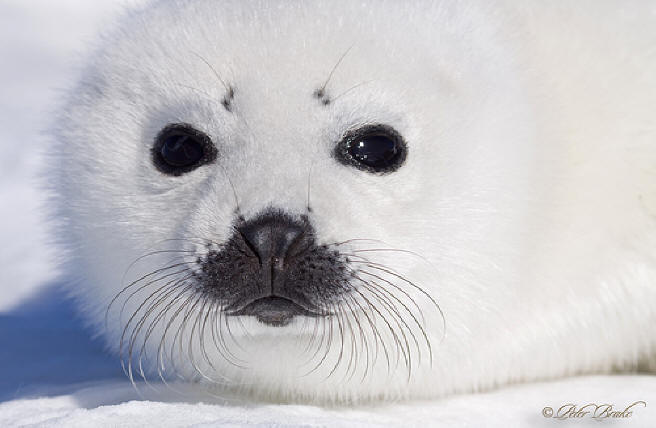Adaptation
Diving
As stated in the habitat section, harp seals spend a lot of
their time in the water. A seal can spend approximately 15
minutes submerged without having to come back up for air.
They conserve oxygen by lowering their heart rate by 90%; only the
nervous system and sense organs receive a normal flow of blood.
After swimming for a while harp seals do not wear out easily because
of the lack of lactic acid in their muscles as other animals
would. Unfortunately harp
seals need time to rest after a swim in order for their body to
return to is normal chemistry.
Harp seals, just like all other pinnipeds, have well adapted
lungs for the semi aquatic lifestyle. The airways of pinnipeds
are supported by smooth muscle and cartilage, as well as alveoli
(small sacs under the surface of the membrane in cells) most
commonly known as capillaries. They are used as a site of
diffusion for gases and nutrients. The alveoli completely
collapse in a harp seals lungs during deep dives. Unlike
terrestrial animals, harp seals are able to inflate their lungs
even after they collapse due to a pulmonary surfactant system
that they have evolved to have. The surfactant acts as an
anti-adhesive during lung collapse and the reopening of alveoli.

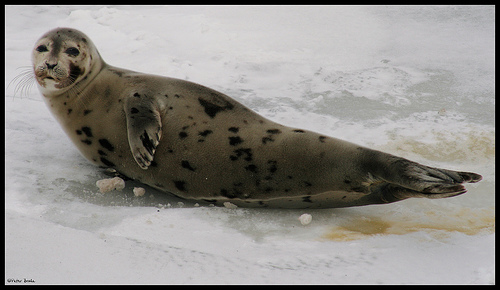
When migrating, harp seals can spend long periods of time at sea,
without ever stepping foot on land. During this time it is not
abnormal for a harp seal to sleep while in the water. Scientists
have found them sleeping for mere minutes at a time, belly up.
The eyes of harp seals are well adapted to seeing both above and
below the surface of the water. Because sight is extremely
important to the seals for navigation, their eyes have evolved
to be proportionally large, and contains a large spherical lens
that helps them focus in on things much more easily.
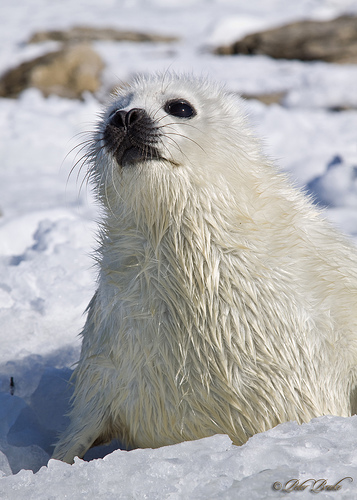 Interestingly enough, in order to deal with the intense glare of
arctic ice harp seals have evolved to have a pupil that is
mobile. Similar to that of a camel, harp seals also have a
membrane that covers the eyes to protect them from the harsh
marine waters.
Interestingly enough, in order to deal with the intense glare of
arctic ice harp seals have evolved to have a pupil that is
mobile. Similar to that of a camel, harp seals also have a
membrane that covers the eyes to protect them from the harsh
marine waters.
The bodies of harp seals are designed to be good for swimming.
Unlike a lot of mammals, the mammary glands and testicles are
found under the skins surface to minimize the resistance in the
water. It takes far less energy to move without the extra
resistance. Flippers are able to easily move their bodies
straight through the water. Because water is much more dense than
air, the flippers of a harp seal can be much shorter than, for
example, the wings of a bird like a
penguin.
Regulating body temperatures
Harp seals are very good at conserving their body heat. With a
thick layer of blubber under their skin, harp seals are able to
hold their body heat more easily. This layer of fat also
provides a means of buoyancy, stores energy, and gives the seals
a shape that is better suited for the aquatic environment where
they are often found. In young harp seal pups you can find fur on
the surface of their skin in order to keep their small bodies
warm.
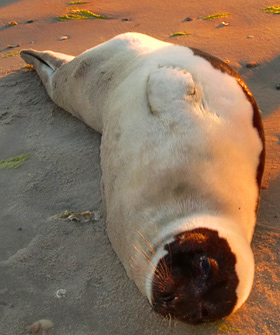
Another interesting way that the seals keep warm has to do with
the same redirect of blood flow that allows them to remain
submerged longer. They lower their heart rate by 90%; supplying
only the nervous system and sense organs with a normal flow of
blood. By redirecting the circulation away from the surfaces,
they are preventing a substantial amount of heat loss.
Skin & Molting
Harp seals are well known for having a fuzzy white coat as a
pup. The fur of a pup is well adapted to the lifestyle of harp
seals. There is a water repellant layer on the outside to help
lessen resistance in water;
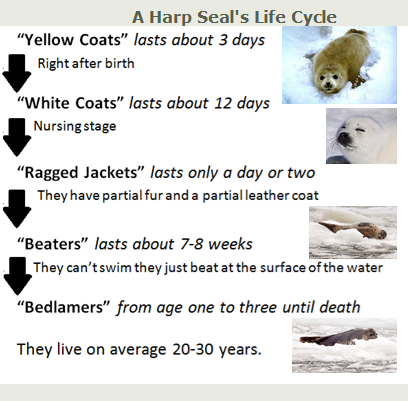 however
there is still a warm insulating layer underneath that to help
with thermoregulation. It was for this very reason that the harp
seals were almost hunted to extinction. Hunters found the fur of
these creatures to be very valuable.
however
there is still a warm insulating layer underneath that to help
with thermoregulation. It was for this very reason that the harp
seals were almost hunted to extinction. Hunters found the fur of
these creatures to be very valuable.
Molting for harp seals happens once a year. During the molting
period the seals get rid of their worn out skin and replace it
with a new one. Most often during this time, harp seals remain
on land; when replacing their skin there is a compromise to how
well they can retain body heat. So as not to risk hypothermia,
harp seals wait for their skin to be ready for the frigid waters
of the arctic.
Harp Seal Digestion
Harp seals, being a carnivorous creature, have a relatively
short digestive tract in comparison with herbivorous animals.
This is due to the fact that a carnivorous diet supplies its
consumer with high quality nutrients. Unlike an herbivorous diet
that requires far more digestion to get the same amount of
nutrients. Because the quality of their diet is so high, harp
seals do not need the excess intestine to soak up the nutrients
as an herbivore would need. Weirdly enough though, harp seals do
have a longer intestinal tract than an animal with a comparable
diet, the minke whale. This could be due to the fact that harp
seals have to work harder than the whales to get to the
locations where their prey are located. Whales are creatures of
the sea and only the sea; whereas seals tire and need to be on
land from time to time. With the excess intestine seals can
receive more nutrients than a whale would eating the same thing,
prolonging the time till they need to return to the water to
feed again.
To learn about the harp seals reproduction techniques, follow
this link!
REPRODUCTION
